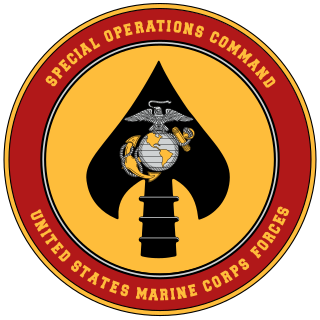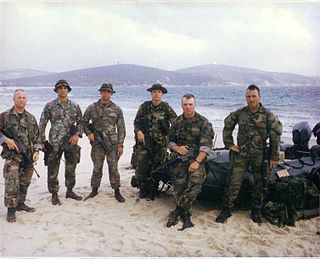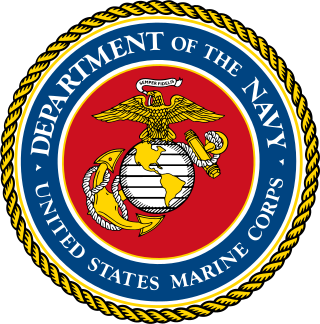
A Marine expeditionary unit is the smallest air-ground task force (MAGTF) in the United States Fleet Marine Force. Each MEU is an expeditionary rapid reaction force ready to answer any crisis, whether it be disaster aid or a combat mission. Marine amphibious unit (MAU) was the name used until the late 1980s.
United States special operations forces (SOF) are the active and reserve component forces of the United States Army, Marine Corps, Navy and Air Force within the US military, as designated by the Secretary of Defense and specifically organized, trained, and equipped to conduct and support special operations. All active and reserve special operations forces are assigned to the United States Special Operations Command (USSOCOM).

Force Reconnaissance (FORECON) are United States Marine Corps deep reconnaissance companies that supply military intelligence to the command element of the Marine Air-Ground Task Force (MAGTF). Force Reconnaissance companies unlike USMC division reconnaissance report to the Marine expeditionary force (MEF) and provide direct action and deep reconnaissance during large-scale operations.

The GROM Military Unit, is a Polish special forces unit and forms part of the Special Troops Command of the Polish Armed Forces. It is believed to consist of around 250 operatives plus support personnel. GROM is considered to be the most elite unit in the Polish Armed Forces.

United States Marine Forces Special Operations Command (MARSOC) is a component command of the United States Special Operations Command (SOCOM) that comprises the Marine Corps' contribution to SOCOM. Its core capabilities are direct action, special reconnaissance and foreign internal defense. MARSOC has also been directed to conduct counter-terrorism and information operations.

The Radio Reconnaissance Platoon is a specially trained Marine Corps Intelligence element of a United States Marine Corps Radio Battalion. A Radio Reconnaissance Team (RRT) was assigned as the tactical signals intelligence collection element for the Marine Corps Special Operations Command, Detachment One. Regular RRTs also participate in SOC operations during Marine Expeditionary Unit, or MEU(SOC), deployments.
In the United States Marine Corps, a Marine Air–Ground Task Force is the principal organization for all missions across the range of military operations. MAGTFs are a balanced air–ground, combined arms task organization of Marine Corps forces under a single commander that is structured to accomplish a specific mission. The MAGTF was formalized by the publishing of Marine Corps Order 3120.3 in December 1963, "The Marine Corps in the National Defense, MCDP 1-0". It stated:
A Marine air–ground task force with separate air ground headquarters is normally formed for combat operations and training exercises in which substantial combat forces of both Marine aviation and Marine ground units are included in the task organization of participating Marine forces.

The United States Marine Corps is organized within the Department of the Navy, which is led by the Secretary of the Navy (SECNAV). The most senior Marine commissioned officer is the Commandant of the Marine Corps, responsible for organizing, recruiting, training, and equipping the Marine Corps so that it is ready for operation under the command of the unified combatant commanders. The Marine Corps is organized into four principal subdivisions: Headquarters Marine Corps, the Operating Forces, the Supporting Establishment, and the Marine Forces Reserve.

The MEU(SOC) pistol, officially designated the M45 MEUSOC, is a magazine-fed, recoil-operated, single-action, semiautomatic pistol chambered for the .45 ACP cartridge. It is a variant of the M1911 for use by the Force Recon Element of the United States Marine Corps' Marine Expeditionary Units from 1985 until 2022. It is assigned NATO Stock Number 1005-01-370-7353.

A Special Amphibious Reconnaissance Corpsman (SARC) is a United States Navy hospital corpsman who provides MARSOC and other USSOCOM units advanced trauma management associated with combatant diving and parachute entry. Traditionally, they are attached to the Marine Corps Force Reconnaissance companies to help support the Command Element of the Marine Air-Ground Task Force in special reconnaissance missions.

A Maritime Special Purpose Force (MSPF) is a United States Marine Corps specialized sub-unit of a Marine expeditionary unit. A MSPF is deployed to give the commanders low profile, two-platoon surgical emplacement in the accessible littoral regions. The MSPF provides the enhanced operational capability and precision skills to complement, enable, and execute selected conventional, maritime special operations. They can also perform operations not resident in traditional amphibious raid companies.

Marine expeditionary unit (special operations capable) (MEU(SOC)) is a program created by the United States Marine Corps (USMC) and the United States Navy (USN) in 1985 for Marine expeditionary units (MEU). The program enhances MEUs providing them with additional training and equipment to become certified as special operations capable with a Maritime Special Purpose Force (MSPF). The designation special operations capable is unique to the Marine Corps and means in relation to special operations. The role of a MEU(SOC) however is not equivalent to the special operations role of special operations forces. Although considered special operations capable a MEU(SOC) does not form part of the United States Special Operations Command (USSOCOM) established in 1987 or the United States Marine Forces Special Operations Command (MARSOC) later established in 2006.
The United States Marine Corps is tasked by Department of Defense directive to "conduct complex expeditionary operations in the urban littorals and other challenging environments" and "conduct amphibious operations, including engagement, crisis response, and power projection operations to assure access." Before 2006, the Marine Corps was the only branch of the Armed Forces that did not have any of its special warfare elements participating in the United States Special Operations Command (USSOCOM), due to confining its special operations capabilities only for the purpose to the Fleet Marine Force.
The reconnaissance mission within the United States Marine Corps is divided into two distinct but complementary aspects; Marine Division Recon and Force Reconnaissance.

1st Force Reconnaissance Company conducted deep reconnaissance and direct action raids in support of I Marine Expeditionary Force requirements across the range of military operations to include crisis response, expeditionary operations and major combat operations. 1st Force Recon Company was deactivated on 26 October 2006 and the majority of the personnel were used to establish the 1st Marine Special Operations Battalion.

The Marine Raider Regiment (MRR), formerly known as the Marine Special Operations Regiment (MSOR), is a special operations force of the United States Marine Corps, which is a part of Marine Corps Special Operations Command (MARSOC). Renamed for its predecessor, the World War II Marine Raiders, this unit is the principal combat component of MARSOC, which is the Marine Corps' contribution to the United States Special Operations Command (USSOCOM).

A critical skills operator (CSO) is a United States Marine in the primary special operations career field of the United States Marine Forces Special Operations Command (MARSOC). CSOs, colloquially known as "Raiders", are awarded the Military Occupational Specialty 0372. CSOs are assigned to Marine Special Operations Teams (MSOT), Companies (MSOC) and Battalions (MSOBs). CSOs are trained to execute a variety of missions. Specialized training also provides capabilities in language fluency necessary for crossing cultural barriers, allowing CSOs to connect with local forces and civilians. It takes, at a minimum, four and a half years to create a Marine CSO; a Marine must have served a minimum of three years or achieved the rank of at least lance corporal before being considered a MARSOC candidate.
Ground Intelligence Officer is a primary military occupation code of a U.S. Marine Corps intelligence officer. Ground intelligence officers serve as staff officers and commanders in the operating forces and are responsible for analyzing intelligence and planning, deployment and tactical employment of ground surveillance and reconnaissance units. The Ground Intelligence Officer can be a Recon Marine after their training is done.

The 1st Marine Raider Battalion is a special operations forces of the United States Marine Corps and a subordinate combat component of the Marine Corps Special Operations Command. The Battalions' organization was finalized in 2006 and is one of three battalions of the Marine Raider Regiment.















